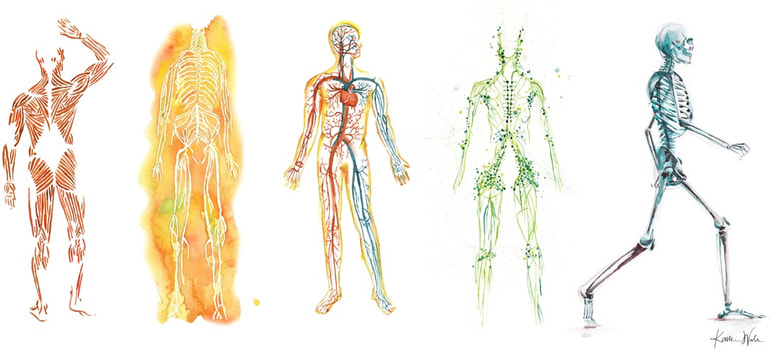Back
Fascial Counterstrain (FCS)
By Shannon Strauch, PTA, STMT-1 on 9/12/2024

Introduction
In recent years, people have become more aware of the importance of fascia, a connective tissue that runs throughout the body, affecting everything from movement to pain management. One advanced therapeutic approach that targets fascia isFascial Counterstrain
. This technique provides a gentle yet highly effective way to address pain and dysfunction in the body's soft tissue system.What is Fascial Counterstrain?
Fascial Counterstrain is a unique, hands-on therapy designed to treat areas of tension or dysfunction in the fascial systems causing trapped inflammation. Fascia is the web-like network of connective tissue that surrounds muscles, organs, and other structures, helping to hold the body together and support movement. When fascia becomes restricted or inflamed, it can cause pain, stiffness, and poor function.This technique involves the identification of "tender points" in the fascia, which signal areas of tension or imbalance. By applying gentle pressure and repositioning the body, the therapist helps reset these points, allowing the fascia to relax and function properly again.
History and Development
Fascial Counterstrain was developed by Dr. Lawrence Jones in the mid-20th century and has since evolved with advancements in understanding fascia and biomechanics. Dr. Jones initially created the Strain-Counterstrain method, which focused on musculoskeletal pain. Over time, Fascial Counterstrain emerged as a more specialized branch created by Brian Tuckey PT, OCS, JSCCI, that targets the fascial system itself, addressing not just muscles and bones but also blood vessels, nerves, and even organs.How Does Fascial Counterstrain Work?
The core idea behind Fascial Counterstrain is that fascia, like other tissues, can develop dysfunction due to injury, stress, or chronic conditions. These dysfunctions create tender points, which are highly sensitive to touch. By applying precise, gentle pressure to these tender points, a therapist can reduce tension, allowing the fascia to release and return to its natural state. This helps alleviate pain and restore the body’s mobility.Benefits of Fascial Counterstrain
Fascial Counterstrain offers numerous benefits, including:Pain Relief:
Helps to reduce acute and chronic pain by addressing the root cause in the fascia.
Improved Mobility:
Restores proper movement patterns by releasing fascial restrictions that limit flexibility.
Enhanced Healing:
Promotes better blood flow and lymphatic drainage, aiding recovery after injuries or surgeries.
Reduced Stress:
The gentle nature of this therapy helps calm the nervous system, making it a relaxing and restorative treatment.
Conditions Treated with Fascial Counterstrain
Fascial Counterstrain is used to treat a wide range of conditions, including:Chronic musculoskeletal pain (e.g., back pain, neck pain, joint pain)
Headaches and migraines
Pelvic floor dysfunction
Post-surgical pain and scar tissue restrictions
Sports injuries (e.g., sprains, strains)
Digestive issues related to fascial tension
Fibromyalgia
What to Expect During a Fascial Counterstrain Session
A Fascial Counterstrain session typically lasts between 45 to 60 minutes. The therapist will first assess the patient’s posture, movement, and specific areas of discomfort. They will then identify tender points in the fascia and apply gentle, sustained pressure to those areas. The patient is usually positioned in a way that minimizes discomfort, allowing the fascia to release naturally.Unlike other manual therapies, Fascial Counterstrain does not involve forceful manipulation or deep tissue work, making it suitable for people of all ages and those with acute pain. After a session, patients often feel immediate relief, though some may require multiple treatments for long-standing issues.
Conclusion
Fascial Counterstrain is an innovative, non-invasive therapy that targets the body’s fascial system to alleviate pain, improve movement, and support overall healing. By addressing the underlying cause of dysfunction in the fascia, this technique offers a lasting solution to chronic pain and other health issues.Final Thoughts
If you’re dealing with persistent pain, restricted movement, or other health challenges related to the fascial system, Fascial Counterstrain may be a valuable addition to your treatment plan. It’s a gentle yet effective way to help your body heal and restore balance.For more information or to find a certified practitioner, explore resources such as the Fascial Counterstrain Association or speak with your healthcare provider about how this therapy could benefit you.
Fascial Counterstrain Technique
Read More:
How Chronic Pelvic Congestion in Men Contributes to Prostatitis By Shannon Strauch, PTA, STMT-1 on 12/11/2024 How lymphatic issues can cause symptoms of prostatitis Prostatitis and Tight Pelvic Floor Muscles: A Comprehensive Guide By Shannon Strauch, PTA, STMT-1 on 12/10/2024 How a tight pelvic floor can be the reason for prostatitis symptoms
Are you ready to live pain free?
Request An Appointment